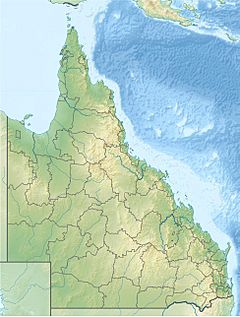Holroyd River facts for kids
Quick facts for kids Holroyd |
|
|---|---|
|
Location of Holroyd River mouth in Queensland
|
|
| Country | Australia |
| State | Queensland |
| Region | Far North Queensland |
| Physical characteristics | |
| Main source | McIlwraith Range below Mount White 187 m (614 ft) |
| River mouth | Gulf of Carpentaria Kulinchin Outstation 0 m (0 ft) 14°09′54″S 141°35′44″E / 14.16500°S 141.59556°E |
| Length | 325 km (202 mi) |
| Basin features | |
| Basin size | 10,286 km2 (3,971 sq mi) |
| Tributaries |
|
The Holroyd River is a river located in the northern part of Queensland, Australia. It flows across the Cape York Peninsula, which is a large area of land pointing northwards. This river is an important part of the natural environment in Far North Queensland.
Where the River Flows
The Holroyd River begins in the McIlwraith Range, a mountain range that is part of the larger Great Dividing Range. Its starting point, called the headwaters, is found south of Mount White.
From there, the river flows towards the west. It forms many different paths, like braids in hair, as it moves through the quiet, undeveloped countryside. Eventually, it joins with the Kendall River near a place called Kulinchin Outstation. After this, the combined rivers empty into the Gulf of Carpentaria, which is a large, shallow sea on Australia's northern coast.
River Branches and Surroundings
The Holroyd River has eight smaller streams, called tributaries, that flow into it. These include the Kendall River, Sandlewood Creek, Station Creek, Potlappa Creek, The Big Spring, First Spring, Christmas Creek, and Kendle River.
The entire area that collects water for the river, known as its catchment area, covers about 10,286 square kilometres (3,971 sq mi). A smaller part of this area, about 60 square kilometres (23 sq mi), is made up of estuarine wetlands. These are special wet areas where the river meets the sea, and the water is a mix of fresh and salt water.
The land around the river is very diverse. You can find tropical savannah woodlands, which are like open forests with scattered trees. There are also wide-open grasslands, sandy beach ridges, and areas with paperbark trees, which are known for their unique peeling bark.
River's History and People
The Holroyd River was given its name in 1864 by Francis Lascelles Jardine. He was a pastoralist, meaning someone who raises livestock like cattle or sheep on large farms. Jardine named the river after Arthur Todd Holroyd, who was an explorer, a doctor, and a politician.
For thousands of years, the land around the Holroyd River has been home to several groups of Indigenous Australian people. These traditional owners include the Wik, Bakanh, Thaayorre, and Kaanju peoples. They have a deep connection to the land and its waterways.
One of the traditional languages spoken in this area is Kugu Muminh, also known as Kuku-Muminh. This language is connected to the landscape within the local government area of the Cook Shire.


